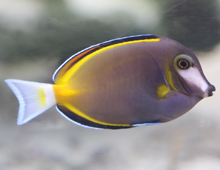Description: The adult Powder-brown tang has a disc-shaped brown to black body with two broad bands. A white band stretches from the lower edge of the eye to the upper lip and an orange band is located on the outer part of the dorsal fin. A wishbone-shaped yellow marking runs along the body. The area in front of the caudal fin and at the base of the pectoral fins is also yellow. The pectoral, anal and dorsal fins are dark brown to black with light blue highlights at the tips. The tail is blue with a yellow vertical bar. On each side of the caudal peduncle is a single spine (scalpel). The juvenile is light brown in the middle of its body with shades of yellow around the top and bottom of its body. The anal fin is a combination of yellow and dark brown. There is white on its face, but not as pronounced as in the adult.
Size: Adult Powder-brown tangs reach 8.3 inches (21 cm) in length.
Behavior: The sharp spines (scalpels) are used for defense and to establish dominance. When they are not in use, they are folded down inside a groove. They prefer shallow exposed environments and form small to large groups.
Diet: Powder brown tangs are herbivores, feeding mostly on algae.
Reproduction: This group performs group spawning in the ocean, usually in the evening. They will form a group and scatter eggs and sperm out in the open water. The eggs each contain a single oil droplet to keep them afloat, thus making
them pelagic. After roughly 24 hours, the eggs hatch into clear larvae about 0.079 inches (0.2 cm) long. Over the next several weeks the larvae will gradually evolve, changing into juveniles.
Habitat/range: Powder-brown tangs inhabit lagoons, outer reefs and coastal areas at depths of 16 – 25 feet (5-20 m). They are found in a large geographical range in the Indo-West Pacific.
Status: Listed as Least Concern on the IUCN Red List.



